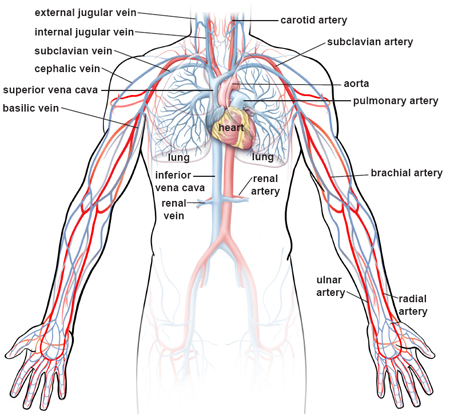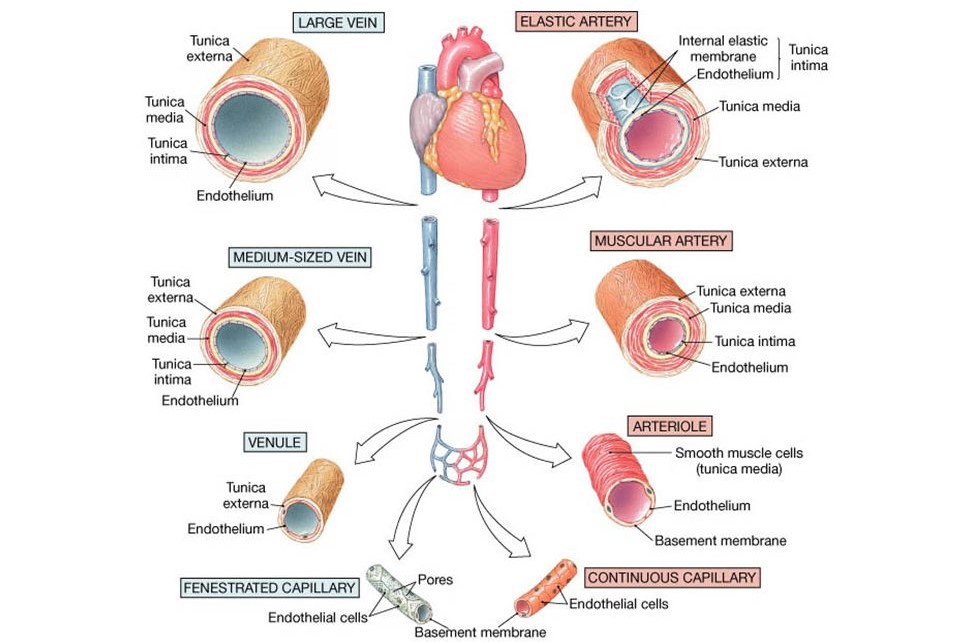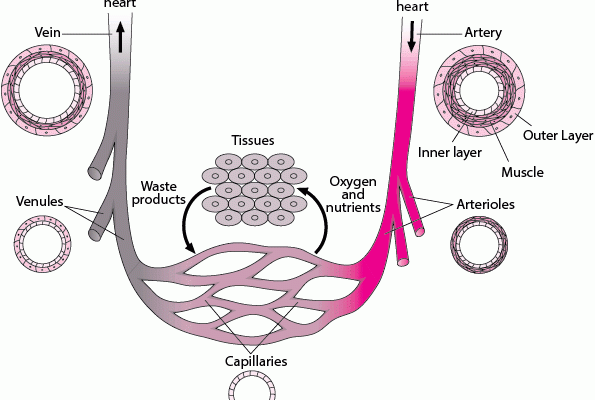Have you ever wondered how blood travels through your body , delivering oxygen and nutrients to your cells? It’s all thanks to an amazing network of blood vessels that run throughout your body from your heart to your toes. These blood vessels come in different shapes and sizes, each with its own unique job to keep your body healthy and functioning properly.
In this article we’ll take a closer look at blood vessels from their structure and function to the different types of vessels and the role they play in keeping you alive and well.
Table of Contents
Blood Vessels – Definition
Blood vessels are hollow tubes similar to pipes that form a complex network throughout the body carrying blood to and from all parts of the body.They transport blood in both directions i.e. from the heart to all other parts of the body and from all body parts back to the heart.
Blood vessels come in different sizes and types. It includes arteries, veins and capillaries. Each of them has their own unique structure and function that allows them to perform their important role in the circulatory system.
Types of Blood Vessels
There are three types of blood vessels – Arteries, Veins and Capillaries.
Each type of vessel has unique structural and functional characteristics that are important for maintaining healthy blood flow and efficient delivery of oxygen and nutrients to cells. In this section we will explore the different types of blood vessels in more detail –

Arteries
- Arteries are thick-walled blood vessels that carry oxygenated blood away from the heart to the body’s tissues and organs.
- They have a smaller lumen (inner diameter) compared to veins which helps to maintain blood pressure as blood is pushed through the circulatory system.
- Arteries are divided into two main types – elastic arteries and muscular arteries.
- Elastic arteries such as the aorta and pulmonary artery are the largest and most elastic and they stretch and recoil with each heartbeat to help regulate blood pressure.
- Muscular arteries on the other hand have more smooth muscle in their walls and can change diameter to help regulate blood flow to specific areas of the body.
- Arteries are located deep within the body and are typically red in color due to their oxygen-rich bloo
Veins
- Veins are thin-walled translucent blood vessels that are blue in color and carry impure or deoxygenated blood from all parts of the body back to the heart.
- Compared to arteries veins have thinner walls and are less muscular.
- They have a larger lumen compared to arteries, which allows them to hold more blood at a lower pressure.
- Veins are often located closer to the skin’s surface and have one-way valves that prevent blood from flowing backward.
- This one way valve helps blood return to the heart against the force of gravity.
- Veins are under lower pressure compared to arteries and move in an upward direction from the cells, tissues and other organs to the heart.
- Veins are also classified into different types such as – Superficial veins and Deep veins.
Capillaries
- Capillaries are the smallest blood vessels in the body and they connect arteries and veins.
- Their thin walls allow for the exchange of gasses, nutrients and waste products between the blood and the body’s tissues.
- Capillaries are so small that blood cells have to pass through them one at a time and they are located in almost every tissue in the body.
- The network of capillaries is so extensive that no cell in the body is more than a few micrometers away from a capillary.
- They are also responsible for regulating blood flow and blood pressure in the body.
Also Check – 15 Important Differences Between Arteries and Veins
Also Check – 7 Structural and Functional Difference Between Arteries Veins and Capillaries
Also Check – Transportation in Human Beings
List Of Blood vessels entering and leaving the Heart, Liver and Kidney

3 Blood Vessels entering the Heart
- Anterior vena cava (from upper parts of our body into the right atrium) – It is formed by the union of jugular vein and subclavian vein.
- Posterior vena cava (from lower parts of body into right atrium)
- Pulmonary veins (two veins from each lung into left atrium)
2 Blood vessels leaving the Heart
- Pulmonary artery (from right ventricle to lungs)
- Aorta (from left ventricle to all other parts of the body)
2 Blood Vessels entering the Liver
- Hepatic artery (from aorta into liver)
- Hepatic portal vein (from stomach and intestines to liver)
1 Blood vessel leaving the Liver
- Hepatic vein (from the liver into posterior vena cava)
1 Blood Vessel entering the kidney
- Renal artery (from aorta into kidney)
1 Blood vessel leaving the kidney
- Renal vein (from kidney into posterior vena cava)
Also Check – Composition Of Blood
Functions of Blood Vessels
- Transport of Nutrients and Oxygen –
Blood vessels, particularly arteries, transport oxygen-rich blood and nutrients from the heart to all parts of the body. This helps in nourishing the cells and tissues of the body and providing them with the energy they need to function.
- Removal of Waste Products
Blood vessels, particularly veins, transport deoxygenated blood and waste products from the cells, tissues and organs back to the heart. It then pumps it to the lungs for oxygenation and removal of waste products.
- Regulation of Blood Pressure
Arteries play a key role in regulating blood pressure. The muscular walls of arteries can contract or relax. It allows them to regulate blood flow and blood pressure in the body. The constriction of arteries leads to an increase in blood pressure while relaxation leads to a decrease in blood pressure.
- Exchange of Gases, Nutrients and Waste Products
Capillaries are responsible for the exchange of gasses, nutrients and waste products between the blood and tissues. The thin walls of capillaries allow for the efficient exchange of oxygen, carbon dioxide, nutrients and waste products between the blood and tissues. This is the Important role that blood vessels play in the gaseous exchange.
- Temperature Regulation
Blood vessels play a crucial role in regulating body temperature. The dilation and constriction of blood vessels can help regulate heat loss and heat retention in the body. This helps maintain a constant internal temperature of an organism.
- Protection Against Blood Loss
Blood vessels have the vital function of protecting against the loss of blood during injuries. When a blood vessel is damaged, the smooth muscles in the walls of the blood vessels contract to minimize blood loss and prevent further damage.
- Transportation of Essential Components
Blood vessels help in the transportation of nutrients, water, minerals, hormones and all other essential components required for the different body metabolism. This helps to maintain the proper functioning of the body and ensure that all tissues and organs receive the nutrients and oxygen they need to function properly.
Also Check – Types and Functions of Blood Vessels
Layers of Blood Vessels
Blood vessels are composed of three distinct layers which are collectively referred to as tunics. These layers are present in both arteries and veins although they differ in thickness and composition between the two types of blood vessels.

Tunica Intima
- The innermost layer of blood vessels is called the Tunica Intima.
- It is a thin, delicate layer of endothelial cells that form the inner lining of the vessel.
- This layer is in direct contact with the blood and helps prevent clotting and maintain blood flow.
- It also plays a role in regulating the diameter of the vessel and controlling blood pressure.
Tunica Media
- The middle layer of blood vessels is called the tunica media.
- It is a thicker layer of smooth muscle cells and elastic fibers that provide strength and elasticity to the vessel.
- This layer is much thicker in arteries than in veins, reflecting the higher blood pressure in arteries.
- The smooth muscle cells in this layer contract and relax to regulate blood flow and blood pressure.
Tunica Adventitia
- The outermost layer of blood vessels is called the Tunica Adventitia.
- It is a connective tissue layer that provides structural support to the vessel.
- This layer contains collagen and elastic fibers that give the vessel strength and help it resist external forces.
- The tunica adventitia also contains nerves and small blood vessels that supply oxygen and nutrients to the vessel wall.
Blood Pressure and Circulation
- Blood pressure is the force exerted by circulating blood against the walls of blood vessels. It is a vital component of the circulatory system as it helps maintain blood flow to all organs and tissues in the body.
- Blood pressure is determined by two factors – the strength of the heart’s contractions and the resistance of the blood vessels.
- Arteries have a higher blood pressure than veins which reflects their role in carrying oxygenated blood from the heart to the rest of the body.
- The force of blood flowing through arteries is strongest during systole, which is the contraction of the heart’s ventricles. During diastole, which is the relaxation of the ventricles, the blood pressure in the arteries decreases.
- Veins have a lower blood pressure than arteries because they are responsible for carrying deoxygenated blood back to the heart.
- The blood pressure in veins is also affected by the contraction of the surrounding skeletal muscles which helps propel the blood towards the heart. Unlike arteries, veins contain one-way valves that prevent blood from flowing backwards.
Diseases and Disorders of Blood Vessels
Blood vessels are Important for the proper functioning of the circulatory system and any damage or malfunction can have serious consequences for the body. The causes of these conditions var but risk factors include genetics, lifestyle choices such as smoking and poor diet and medical conditions like diabetes and obesity. Symptoms of these conditions can include chest pain, shortness of breath, leg pain and swelling among others.
Treatment options depend on the condition and severity, but may include lifestyle changes, medications and surgery. It is essential to seek medical attention if you experience any symptoms of blood vessel disorders or have a family history of these conditions.
Following are examples of fewl common diseases and disorders that can affect blood vessels –
- Atherosclerosis – Atherosclerosis is a condition where fatty deposits, cholesterol and other substances build up on the inner walls of arteries, making them narrow and less flexible. This can reduce blood flow to vital organs and increase the risk of heart disease, stroke and other health problems.
- Hypertension – Hypertension, or high blood pressure, is a condition where the force of blood against the walls of arteries is consistently too high. This can damage blood vessels and increase the risk of heart disease, stroke and kidney failure.
- Varicose veins – Varicose veins are swollen and twisted veins that often appear on the legs and feet. They occur when the valves in the veins that prevent blood from flowing backward become weak or damaged, causing blood to pool in the veins.
- Peripheral artery disease – Peripheral artery disease is a condition where the arteries in the legs and arms become narrow and clogged, reducing blood flow to the limbs. This can cause pain, cramping and weakness and increase the risk of infection and tissue damage.
- Aneurysm – An aneurysm is a bulge in the wall of an artery, which can occur in any part of the body. Aneurysms can be life-threatening if they rupture, causing internal bleeding.
Frequesntly asked questions on this topic
What are blood vessels?
What are the three types of blood vessels?
What are arteries, and what is their function?
What are the two main types of arteries?
What are veins, and what is their function?
How do veins differ from arteries?
What are capillaries, and what is their function?
How do capillaries differ from arteries and veins?
Can you name some blood vessels entering and leaving the heart, liver, and kidney?
What are the functions of blood vessels?


21 Comments on “Blood Vessels -Definition , Types, Functions, Layers, Blood Pressure , Diseases and Disorders”